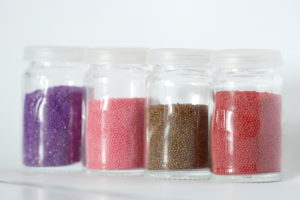SILP gas purification
Overview
By applying thin films of ionic liquids onto silica or alumina support, the mass transport could be enhanced by orders of magnitude due to the large interfacial exchange area on the one hand and the small diffusion time in the thin film of ionic liquid on the other hand. The sulfur content of gas-condensate feed could be reduced below 10 ppm and the then loaded SILP catalyst was re-generated in vacuum. This loading-unloading procedure could be repeated several times without significant loss of performance, resulting in overall time-on-stream of 600 h. Ammonia and other hazardous gases could be irreversibly removed by this technology, making SILP absorbers a promising alternative for gas-mask filters, off-gas purification and CO2 capture technology.
Selected images

Selected publications
- Kuhlmann E., Haumann M., Jess A., Seeberger A., Wasserscheid P.:
Ionic Liquids in Refinery Desulfurization: Comparison between Biphasic and Supported Ionic Liquid Phase Suspension Processes
In: Chemsuschem 2 (2009), p. 969--977
ISSN: 1864-5631
DOI: 10.1002/cssc.200900142
- Kohler F., Roth D., Kuhlmann E., Wasserscheid P., Haumann M.:
Continuous gas-phase desulfurisation using supported ionic liquid phase (SILP) materials
In: Green Chemistry 12 (2010), p. 979
ISSN: 1463-9262
DOI: 10.1039/C004883f
- Kohler F., Popp S., Klefer H., Eckle I., Schrage C., Böhringer B., Roth D., Haumann M., Wasserscheid P.:
Supported ionic liquid phase (SILP) materials for removal of hazardous gas compounds - efficient and irreversible NH3 adsorption
In: Green Chemistry 16 (2014), p. 3560-3568
ISSN: 1463-9262
DOI: 10.1039/c3gc42275e
- Kaftan A., Klefer H., Haumann M., Laurin M., Wasserscheid P., Libuda J.:
An operando DRIFTS-MS study of NH3 removal by supported ionic liquid phase (SILP) materials
In: Separation and Purification Technology 174 (2017), p. 245-250
ISSN: 1383-5866
DOI: 10.1016/j.seppur.2016.10.017